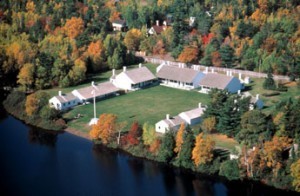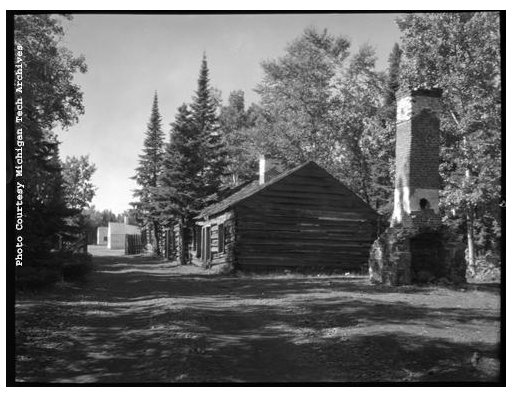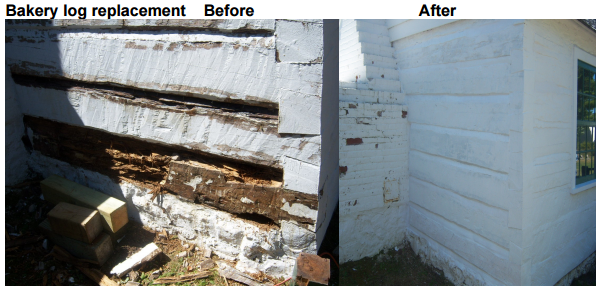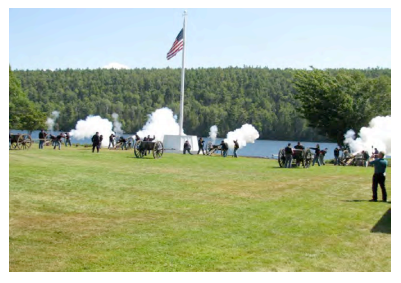
Located towards the top of the Keweenaw Peninsula in Copper Harbor, MI are the remaining structures of Fort Wilkins. Fort Wilkins is Michigan’s northernmost fort constructed in the 1840’s, originally used to keep the area safe now converted into a historical park and camping ground for the public to use and experience what life was like when the fort was an active military site.
Fort Wilkins was initially constructed in 1844 on the northern shore of Lake Fanny Hooe. Initially the fort was constructed and used to maintain peace between the local Native American population and the settlers who moved to the area to mine and harvest the surrounding natural resources. At the beginning the fort was occupied by the U.S. Army with troops numbering around 105 enlisted men. Given the low tension and remoteness of the area, personal were able to successfully keep the area safe and peaceful without major incidents by working with the local populations and enforcement during the copper rush. Fortunately the perceived threats were never an issue and never materialized which rendered the fort of little military significance.

Fort Wilkins was initially constructed as a typical stockade frontier fort with a wooden wall perimeter and initially had 27 buildings. The fort was constructed with nearly everything needed for a small town to run and operate. Given the amount of time required for resupplies to reach the area from other parts of the country it was a necessity for much of the items needed to have the ability to be created on site from the surrounding natural resources or and able to store the material needed when not available. At this times paved road systems and motor vehicles did not exist which in turn creates longer lead time for the supplies needed as they needed to be transported using wagons over difficult terrain.
Some of the building mentioned above used in order to keep the fort self-sufficient included a central parade surrounded by the officer’s quarters, guardhouse and a barracks for the military personal stationed there. Enlisted men were also given the opportunity to live in a group of quarters for married men where their entire family could be housed including children. The married quarters were however located just outside of the fort walls in the surrounding area. A hospital was made present to take care of any injured personal as well as people from the surrounding area. Much of the work at this time was dangerous making the hospital an extremely valuable asset to the area. A powder magazine was used in order to store ammunitions for the soldiers as well as a guardhouse. This was a rock and concrete walled structure and is still present at the Fort today. A sutler’s and quartermaster store were constructed towards the rear of the fort for personal amenities. Currently there are 19 structures in total remaining with 12 originally constructed in the 1840’s including one of Lake Superiors’ original lighthouses dating back to 1866. The fort has recently been undergoing restoration efforts and development changes since the 1930’s, in order to maintain the historical feeling which allows visitors to obtain the same or similar experience as the original inhabitants who lived here by not only staying at its campgrounds or visiting but also take tours with interactive demonstrations.

Long gaps of inactivity, little use of Fort Wilkins for military purposes, and the declining need for a stationed garrison in the area eventually lead to the abandonment and care of the facility to be transferred over to the State of Michigan in 1923. The first reduction in garrison was in 1846 when the United States entered a war with Mexico. The increased need for troops resulted in nearly half of the garrison at the time to be transported to the warfront to aid in the war efforts. A little more than a year later the rest of the garrison were required for the war effort and a single person was left in order to maintain the fort and surrounding facilities. Given the lasting state of peace in the area and the need to soldiers in the war the garrison was not refilled until 1867 fallowing the end of the civil war. The new garrison consisted of US Army troops just as in the previous occupation when the fort was first constructed. The Army kept a garrison posted until 1870 in August when the fort and surrounding area was permanently abandoned.
Since 1923 and forward Fort Wilkins has been operated as a unit of the Michigan department of history, arts, and libraries. Once the fort became a state park all the original building still present were stabilized and are currently being restored. Michigan Technological University and its archaeology department have even worked with the fort’s caretakers to uncover and reclaim areas including the foundation of past buildings. As stated previously only 12 of the current 19 building are original however much research and work is still needed and underway in order to reconstruct the remaining 8 of the original 27. Through the restoration and reconstruction of these building visitors will have a greater understanding of the forts military past which in turn would lead to a greater number of visitors.
One of the main attractions and sources of revenue for Fort Wilkins is the campground itself they created and manage. In the years 2014 and 2013 alone the fort saw roughly 121,000 and 122,977 visitors respectively, provided by reports from their website. The relatively high visitor count for such a relatively small park can be attributed to the campground itself as well as the additional attractions including interactive events and demonstrations. The demonstrations are set in the original time period when the fort was used for military purposes. Part of keeping the visitor count this high can be contributed to the continual improvement of the forts building and grounds which seem to be under almost constant restoration.
As described above many people visit and stay at the fort every year, which makes creating, running, and participating in the various historical interactive and time period demonstration programs more accessible. Traditional open lot style camp spots are available with fire pits as well as a single cabin that can be rented when visitors want to stay. In addition to the camping locations modern amenities have also been added in order to attract more people including families. Some of the installed facilities include shower rooms and bathroom locations as well as a general store. All of these features can be seen on the map below. While these may take some authenticity away from the original layout it increases the number of campers, which in turn increases the revenue that is used to operate and restore the fort facilities and allow for the exposure of what the fort used to be like. A current map of Fort Wilkins and the park facilities can be seen directly below.

Much of the material used in the creation of the buildings is wood and over time has needed extensive restoration in order to maintain the mid-19th century authenticity and attraction of Fort Wilkins. Unfortunately given the abandonment earlier in its life many of the building needed extensive restorations with even some of the building being lost sue to decay. Much of the restoration work includes replacing the wooden components of each building where needed.
An example of some of the restoration work that has been underway and completed can be seen in the image below of the Bakery exterior restoration project. Completed in 2013 it can be seen that logs have been replaced with the utmost care in order to preserve the original look and feel of the building. This is considered an extremely important aspect to any historical restoration as it preserves the interaction between the visitors and the object as closely as possible to the original time. With continual restoration of the current building as well excavation and reproduction of old building future visitors will continue to receive an improved perception of what life was like when the fort was an active military post.


In addition to the campground Fort Wilkins also offer a variety of activates for visitors to watch and even participate in. In 2013 alone roughly 1470 people attended the 39 evening programs held on the fort grounds. Some of these programs include the Living History Programs. This program includes actual people play the roles of how people lived during the active fort time during the last year of the garrison. This not only allows people to imagine how life was but to also experience it in a way. Another program includes active military drills much like the Artillery drill which can be seen in the image below. While visitors won’t actually be able to participate in this particular program for safety reasons they are able to watch and gain a deeper experience into the kind of everyday things people in this area experienced.
Primary Sources
Last, First M. Photograph Title. Year Created. Photograph.Museum/Institution, Location. Database Title. Web. Date Month Year Accessed.
1. Reeder, John T. Fort Wilkins. Year Unknown. Photograph. Keweenaw Digital Archives. web. November 2015
2. Reeder, John T. Fort Wilkins. Oct 27. 1912. Photograph. Keweenaw Digital Archives. web. November 2015
3. Reeder, John T. Fort Wilkins Birds Eye View. Year Unknown. Photograph. Keweenaw Digital Archives. web. November 2015
4. Isler. Cities & Towns – Copper Harbor. Year Unknown. Photograph. Keweenaw Digital Archives. web. November 2015
5. Strittmatter, Robert. Fort Wilkins Historic State Park 2014 Year In Review. Rep. no. 1. N.p.: n.p., n.d. Print.
6. Strittmatter, Robert. LOOKback2013. Rep. no. 1. N.p.: n.p., n.d. Print.
6. Strittmatter, Robert. LOOKback2012. Rep. no. 1. N.p.: n.p., n.d. Print.
Secondary Sources
1.Thomas Friggens (2000). “Fort Wilkins Yesterday and Today” Vol. 1
2.”Watch a History of Fort Wilkins Hosted by Pasty.NET. Part 1,2, and 3″ Fort Wilkins NHA. Pasty Net, n.d. Web. 8 Oct. 2015. <http://www.fortwilkinsnha.org/history.html>.
3.”Recreation Search.” Michigan Site Details Page. N.p., n.d. Web. 7 Oct. 2015. <http://www.michigandnr.com/parksandtrails/Details.aspx?type=SPRK&id=419>.
4. “Fort Wilkins Natural History Association.” Fort Wilkins NHA. N.p., n.d. Web. 10 Oct. 2015. <http://www.fortwilkinsnha.org/>.
